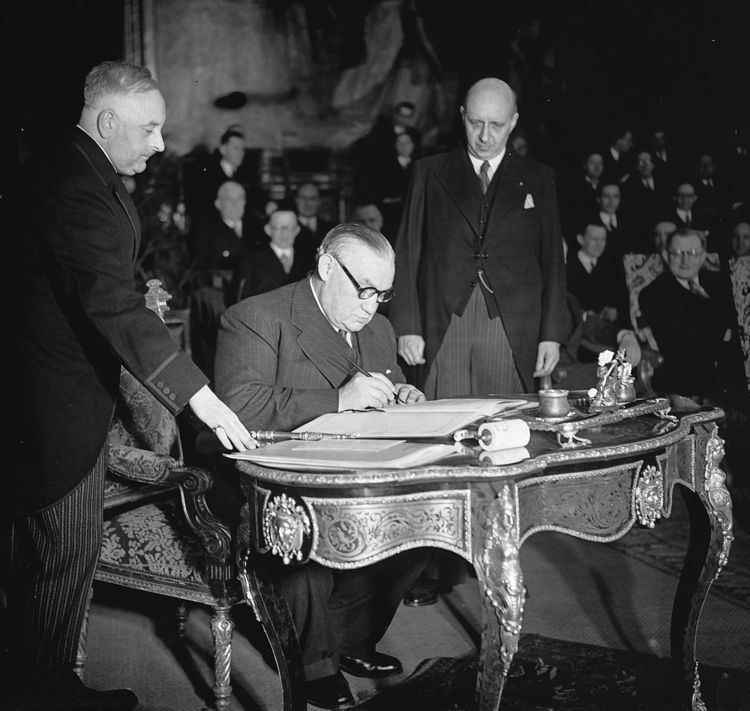Type Founding treaty | Signed 17 March 1948 | |
 | ||
Signatories BelgiumFranceLuxembourgNetherlandsUnited Kingdom | ||
The Treaty of Brussels was signed on 17 March 1948 between Belgium, France, Luxembourg, the Netherlands and the United Kingdom, as an expansion to the preceding year's defence pledge, the Dunkirk Treaty signed between Britain and France. As the Treaty of Brussels contained a mutual defence clause, it provided a basis upon which the 1954 Paris Conference established the Western European Union (WEU). It was terminated on 31 March 2010.
Contents
Background
The Treaty was intended to provide western Europe with a bulwark against the communist threat and to bring greater collective security. The Pact had cultural and social clauses, and concepts for the setting up of a 'Consultative Council'. The basis for this was that a cooperation between Western nations would help stop the spread of Communism.
In that it was an effort towards European post-war security cooperation, the Brussels Pact was a precursor to NATO and similar to it in the sense that it promised European mutual defence. However, it greatly differed from NATO in that it envisaged a purely European mutual defence pact primarily against Germany, whereas NATO took shape the next year, on the recognition that Europe was unavoidably divided into two opposing blocks (western and communist), that the USSR was a much greater threat than the possibility of a resurgent Germany, and that western European mutual defence would have to be atlanticist (i.e. including North America).
In September 1948, the parties to the Treaty of Brussels decided to create a military agency under the name of the Western Union Defence Organization. It consisted of a WU Defence Committee at Prime Ministerial level, and a WU Combined Chiefs of Staff committee, including all the national chiefs of staff, which would direct the operative organisation. Field Marshal Bernard Montgomery (UK) was appointed permanent Chairman of the Land, Naval and Air Commanders-in-Committee, with headquarters in Fontainebleau, France. The nominated commanders-in-chief were General Jean de Lattre de Tassigny (France) as C-in-C, Land Forces, Air Chief Marshal Sir James Robb (UK) as C-in-C, Air Forces, and Vice-Admiral Robert Jaujard (France) for the Navy, as Flag Officer Western Europe. Volume 3 of Nigel Hamilton's Life of Montgomery of Alamein gives a good account of the disagreements between Montgomery and de Lattre which caused much ill-feeling in the headquarters.
Trying to avoid the need for West German rearmament, a treaty aimed at establishing a European Defence Community was signed by the six ECSC members in May 1952 but failed when it was rejected by the French National Assembly in August 1954. This rejection led to the London and Paris Conferences in September and October, with the conclusion that he Treaty of Brussels was amended by the Protocol signed in Paris on 23 October 1954, which added West Germany and Italy to the Western Union Defence Organization. On this occasion it was renamed the Western European Union.
Signing ceremony
The Treaty was signed by the following plenipotentiaries:
NATO
When the division of Europe into two opposing camps became unavoidable, the threat of the USSR and Eastern Bloc became much more important than the threat of German rearmament.
Western Europe therefore sought a new mutual defence pact involving the United States, a powerful military force for such an alliance. The United States, concerned with containing the influence of the USSR, was responsive to this idea.
There was therefore rapid progress on this idea, and secret meetings had already begun by the end of March, where American, Canadian and British officials negotiated over the concept. Eventually, it would lead to the formation of the North Atlantic Treaty Organisation by the North Atlantic Treaty signed in Washington DC in 1949. The Western Union Defence Organization structure was absorbed into NATO from December 1950 to April 1951. NATO's Supreme Headquarters Allied Powers Europe took over the WUDO's defence role.
Paris Agreements
In 1954 West Germany and Italy were invited to join the pact, and accordingly the Brussels Treaty was modified. The Western European Union was established.
Lisbon Treaty
In 2009, the Treaty of Lisbon took over the WEU's mutual defence clause. After the discussion the ten member states decided to terminate the Treaty of Brussels on 31 March 2010. The activities of WEU were terminated by June 2011.
